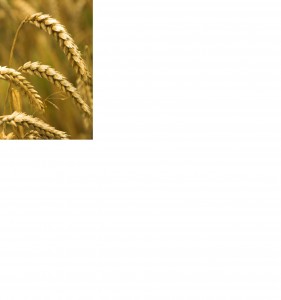 Let’s talk about grains, shall we? Odds are even if you haven’t bought in to the “gluten free” craze, you have at least seen the bevy of products at the supermarket and heard people speaking the lingo, talking about “leaky gut”, making grain-free treats and avoiding anti-nutrients. What’s the big deal about wheat anyways, you might ask? Haven’t we been eating grains for thousands of years? What about whole grains, isn’t that the answer to all of issues with too many carbs and isn’t it more nutritious? Unfortunately the answers that history and science provide don’t put the tasty grain in a very good light.
Let’s talk about grains, shall we? Odds are even if you haven’t bought in to the “gluten free” craze, you have at least seen the bevy of products at the supermarket and heard people speaking the lingo, talking about “leaky gut”, making grain-free treats and avoiding anti-nutrients. What’s the big deal about wheat anyways, you might ask? Haven’t we been eating grains for thousands of years? What about whole grains, isn’t that the answer to all of issues with too many carbs and isn’t it more nutritious? Unfortunately the answers that history and science provide don’t put the tasty grain in a very good light.
Let’s take a quick look back in time to see where the problems all started, around 11,000 years ago. The fossil record shows evidence of humans back to 2 million years ago. For the sake of comprehension, imagine shrinking this time frame down so that it fits into the size of a football field. Up until the last yard line, which represents the “Neolithic era” (around 11,000 years ago), we were all hunter/gatherers. We survived by hunting big game, eating the WHOLE animal (snout to tail), and scavenging for fruits, nuts, berries and tubers. Occasionally we got lucky and happened upon a beehive and if we didn’t get stung to death by some giant prehistoric bees, we got some honey which really got us moving. Our bodies developed over this time to thrive on meat and fat from muscle and organs. The body stored fat and built muscle when there was feast, and drew energy easily from the body’s fat cells when there was famine (say, during the 3 days it took for him to stalk and kill a mastodon or a giant elk). Around the one yard line we started cultivating grains and other plants and domesticating animals. 11,000 years ago is many lifetimes of generations more than we can easily comprehend, but for the evolution of our DNA it is a relatively new development, and some of the items we have introduced our bodies have not adjusted to very well. This does not even account for the modern “feauxd” products of the last 100 years which we currently purchase out of boxes, bags, jars and cans, representing about the last 1/5th of 1 inch of the football field.
So what is it about grains that is getting so much bad press these days? I’m certainly no expert in this field, but it doesn’t take a lot of digging into the scientific literature to see the problems grains bring to the table. First off, too many of these carbs promote chronic high insulin levels, leading to inflammation in the body, hormone disregulation, and fat storage. In an era where so many people are chronically inflammed and conditions such as morbid obesity and diabetis are EVERYWHERE grains need to be acknolwedged for their share of this burden, along with processed sugars and industrial oils.
Second, the grains cause a great deal of damage by attacking your system. EVERYTHING on this planet has a way to try to protect itself from being destroyed to make sure the next generation survives, even plants. In a lot of foods, we benefit from these protections in a symbiotic relationship. Fruits and vegetables develop anti-oxidants and chemicals to protect themselves from the sun and predator bugs, fungus, bacteria and disease. We eat these foods and absorb those nutrients and protective chemical properties which are good for us, and we pass the seeds through in a nice little bit of fertilizer which in the wild would be a great way to ensure the next generation makes it.
Grains, on the other hand, protect themselves via chemical warfare. Wheat does not need us to assist in their dissemination. The grains we eat are actually the seeds of the plant, and they are designed to be disbursed by the wind. In an attempt to ensure their survival (because what we eat when we consume wheat IS the actual next generation and the energy for that next generation to grow) gluten, other plant proteins, phytic acid, and lectins (collectively known as anti-nutrients) interact with our digestive system causing us to get sick and pass the grains out without fully digesting them. Dr. Loren Cordain has an excellent description of this troubling interaction:
“Grains are the seeds of a plant. They’re its reproductive material, and plants don’t make their reproductive material to give away for free to other animals. If they did they’d become extinct, and so the evolutionary strategy that many plants, particularly cereal grains have taken to prevent predation is to evolve toxic compounds so that the predator of the seeds can’t eat them, so that they can put their seeds in the soil where they’re meant to be to grow a new plant and not in the gut of an animal to feed it.”
Let’s take a quick look at the different parts of a grain and why they are so problematic:
Bran (outer shell)- This is what you see on the outside of the grain. There are a host of anti-nutrients designed to prevent the digestion of the grain, and cause irritation of the digestive system. They are also high in phytic acid, which binds to minerals (especially zinc and magnesium) stealing these nutrients from your body, and interferes with digestive enzymes, so the food you are eating is less digested and the nutrients aren’t absorbed as well. You may notice that wheat products are usually “fortified” with lab vitamins. This is because the vitamins in the wheat are biologically unavailable as nourishment, AND the wheat is stealing your vitamins as well. The lab vitamins don’t get absorbed well, so you’re eating a food that at best passes little nutrition to you for all its calories, and at worst is robbing your cells of vital nutrients.
Endosperm-this is what you see when you’re looking at white flour-comprised of mostly starch and a little protein-this is the energy for the next generation to grow. There is not much here that will attack your system but it will lead to insulin spikes, which cause inflammation, hormone disregulation and fat storage.
Germ: This is the embryo of the grain. As you might imagine, this part of the grain has a lot at stake…if you manage to digest it there will be no new generation of wheat. Because of this, it should come as no surprise that the germ contains a host of nasty lectins and other aggressive proteins designed to fight back against predators. Wheat Germ Agglutinin (WGA) is of particular concern, as its defense mechanism is one of intense inflammation in the body. It can also pass the blood-brain barrier, and interferes with gene expression and endocrine function. The germ also contains protease inhibitors that shut down the production of stomach acid. This leaves large, intact, aggressive proteins in the gut, as well as pathogens such as fungus, bacteria and parasites which in a situation of normal stomach acid would have been killed off. These large aggressive proteins make it through to your intestines where they don’t belong. These proteins are chemically similar to the chemical “key” that opens your intestinal cell gates allowing digested nutrients to pass into the blood stream (known as “leaky gut syndrome”). The large undigested and aggressive proteins enter the blood stream and the body sees these particles as foreign invaders. Because these proteins look a lot like the body’s natural proteins, the immune system starts creating anti-bodies that are literally being programmed to attack the body’s healthy cells. This causes inflammation leading to problems like (but not limited to) autoimmune disease, asthma, acne, allergies, fertility issues, and migraines, as well as opening the gates (the intestinal barrier) wide for other pathogens to enter into your body instead of being expelled (bacterial infections, fungal infections, parasites, heavy metals and other toxins).
Non-wheat pseudo grains like corn, oats, and quinoa don’t contain the same proteins such as gluten, but they do still contain numerous other proteins that are very aggressive in the body, steal nutrients, irritate the gut, and cause autoimmune responses. Here are just a few of the problems they can cause:
Oats: contain proline, an amino acid very difficult to digest. Prolamines result in gut irritation and systemic inflammation.
Corn: contains a similar amino acid called zein, which is also difficult to digest leading to a similar state of irritation and inflammation.
Quinoa: contains high levels of saponins, which cause intestinal permeability similar to WGA.
Also, these pseudo grains are usually processed in places with gluten containing grains, and cross-contamination often occurs, so you’re likely getting a gluten exposure that way.
In addition, these pseudo-grains also produce blood sugar spikes and dips, and they contain chemicals that act on your opiate receptors (similar to grain). So between the blood sugar cravings inducing extra hunger, and the addictive chemical bonds, you end up unsatisfied and wanting MORE of these damaging foods.
This is by no means an exhaustive discussion of the damage that grains can cause. If you’re interested in doing further research, here are some excellent resources to get you started:
The Paleo Soultion, The Original Human Diet by Robb Wolf
http://articles.mercola.com/sites/articles/archive/2012/01/21/grains-causing-gut-leaks.aspx
http://chriskresser.com/9-steps-to-perfect-health-1-dont-eat-toxins
 Nourished and Grounded Nutritional and Lifestyle Consulting, Functional Diagnostic Nutrition Practitioner, and MTHFR Expert
Nourished and Grounded Nutritional and Lifestyle Consulting, Functional Diagnostic Nutrition Practitioner, and MTHFR Expert




11 comments
Pingback: Don’t Fear the Fat! | Nourished and Grounded
Pingback: A Plea for Protein | Nourished and Grounded
Pingback: Paleo Crispy Baked Okra | Nourished and Grounded
Pingback: Paleo Roasted Smashed Turnip Mix and Wilted Bacon Greens | Nourished and Grounded
Pingback: Paleo Quick Thai Coconut Curry | Nourished and Grounded
Pingback: Paleo Beef Liver Pate | Nourished and Grounded
Pingback: Guiltless Thanksgiving (Surviving the Holidays with Your Health Intact-Part 3) |
Pingback: Creamy Paleo Pumpkin Pie and Pomegranate Honey Glazed Ham | Nourished and GroundedNourished and Grounded
Pingback: Surgical/Traumatic Injury Recovery - Nourished and Grounded
Pingback: Crispy Baked “Smokra” Bites (Incredibly Simple…and Hubby-Approved!) | Rachel's Nourishing Kitchen
Pingback: Crispy Baked Okra & Smokra Bites | Hometown Harvest